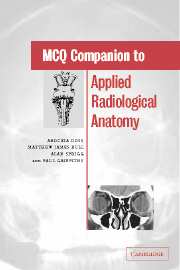Paediatric anatomy
Published online by Cambridge University Press: 04 February 2010
Summary
Concerning the various differences between paediatric and adult anatomy:
(a) The weight of the neonatal suprarenal gland may be 30% of that of a neonatal kidney.
(b) Gastro-oesophageal and vesico-ureteric reflux are common in neonates.
(c) There is less mediastinal and retroperitoneal fat in children compared with adults.
(d) Neonatal kidneys have a more lobulated contour compared with adults.
(e) The curved diaphragm results in mirror image artefacts during ultrasonography of children.
Concerning cranial ultrasonography:
(a) It is performed through the anterior fontanelle during the first year of life.
(b) Axial sections, which correlate with axial sections of computerized tomography, are obtained at the level of the basal cisterns.
(c) The choroid plexuses in the lateral ventricles are echobright.
(d) Pulsating middle cerebral arteries are seen in the Sylvian fissure.
(e) The germinal matrix lines the floor of the lateral ventricles above the heads and bodies of the caudate nuclei.
Regarding paediatric ultrasonography:
(a) The quadrigeminal cistern is echopoor in the neonate.
(b) Asymmetry of the ventricles is usually pathological in the neonatal brain.
(c) Incomplete ossification of the posterior spinal arches allows an acoustic window for spinal sonography.
Paediatric anatomy ANSWERS
(a) True – due to a large size in neonates the adrenal can be mistaken for the kidney in renal agenesis.
(b) True – and they may be physiological.
(c) True – on axial CT of the chest in children, it is difficult to assess mediastinal structures due to lack of inherent contrast.
(d) True – due to persistence of fetal lobulation after birth.
(e) True – hence gives a false appearance of a mass in the upper abdomen or lower chest.
- Type
- Chapter
- Information
- MCQ Companion to Applied Radiological Anatomy , pp. 112 - 120Publisher: Cambridge University PressPrint publication year: 2003



